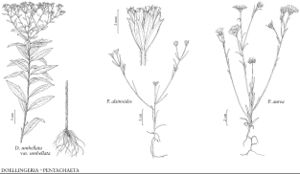Pentachaeta
Trans. Amer. Philos. Soc., n. s. 7: 336. 1840.
| Taxon | Illustrator ⠉ | |
|---|---|---|
 | Doellingeria umbellata Pentachaeta alsinoides Pentachaeta aurea | Marjorie C. Leggitt Barbara Alongi Barbara Alongi |
Annuals, 2–48 cm (taprooted). Stems erect to ascending, simple or branched on proximal 1/2, glabrous or sparsely villous to tomentose. Leaves basal and cauline; alternate; sessile; blades (1-nerved), narrowly oblanceolate to linear or filiform, margins entire, usually ciliate, faces glabrous or sparsely pilose. Heads radiate, disciform, or discoid, borne singly (at ends of branches, pedunculate). Involucres campanulate to turbinate (3–7, ×) 2–8 mm. Phyllaries 7–25 in 2–3 equal or 3–5 unequal series, 1-nerved (midnerves evident, not raised),elliptic to obovate or narrowly lanceolate, usually convex, herbaceous, margins sharply delimited, hyaline, abaxial faces glabrous or sparsely hirsuto-pilose, eglandular or sparsely and minutely glandular. Receptacles flat to slightly convex, weakly pitted, epaleate. Ray-florets 0, or 1–70, pistillate, fertile; corollas white, yellow, or reddish (laminae coiling or 0). Disc-florets 3–91, bisexual, fertile; corollas white or yellow, tubes shorter than narrowly funnelform, linear-tubular, or clavate throats, lobes 3 or 5, erect, triangular; style-branch appendages linear. Cypselae oblanceoloid, subterete to slightly compressed, (3–) 5-ribbed, strigose; pappi usually persistent, of (3–) 5–20 (usually ca. 5 or multiple of 5), tawny, sometimes basally dilated, barbellate, apically attenuate bristles in 1 series, sometimes 0. x = 9.
Distribution
Calif., nw Mexico
Discussion
Species 6 (6 in the flora).
Five of the Pentachaeta species are restricted to California; the sixth occurs in southern California and adjacent Baja California. The plants are small, slender annuals with linear, entire, ciliate leaves, mostly yellow-rayed heads on long peduncles, and pappus bristles in multiples of five. D. D. Keck (1958) united Pentachaeta with Chaetopappa; G. S. Van Horn (1973) maintained it as a separate genus. Chaetopappa differs in various ways, including its consistently white (to bluish) rays, triangular to deltate style appendages (disc), and base chromosome number of 8. Pentachaeta is most closely related to the chiefly Californian annuals Rigiopappus and Tracyina (G. L. Nesom 1994).
Selected References
Lower Taxa
Key
| 1 | Ray florets 0, or pistillate florets 1–6, corollas either reduced to filiform, essentially elaminate tubes, or with inconspicuous, white laminae | > 2 |
| 1 | Ray florets 5–70, laminae conspicuous, white or yellow | > 3 |
| 2 | Stems diffusely branched; pistillate florets (4–)5(–6), corollas elaminate; disc corollas linear-tubular, lobes 3 | Pentachaeta alsinoides |
| 2 | Stems simple to few branched; pistillate florets 0 or 1–3, corollas with or without laminae; disc corollas club-shaped, widened through limbs, abruptly contracted at lobes, lobes 5 | Pentachaeta exilis |
| 3 | Ray laminae white, sometimes purplish-tinged; San Francisco Bay region | Pentachaeta bellidiflora |
| 3 | Ray laminae yellow; s California | > 4 |
| 4 | Ray florets 7–12; largest leaves to 25 mm | Pentachaeta fragilis |
| 4 | Ray florets 14–52; largest leaves to 50+ mm | > 5 |
| 5 | Pappus bristles 5–8; phyllaries ovate-elliptic to oblong-elliptic, glabrous or sparsely short-strigose; leaves 1(–3) mm wide | Pentachaeta aurea |
| 5 | Pappus bristles 8–12; phyllaries narrowly lanceolate, hirsuto-pilose; leaves 3–6 mm wide | Pentachaeta lyonii |